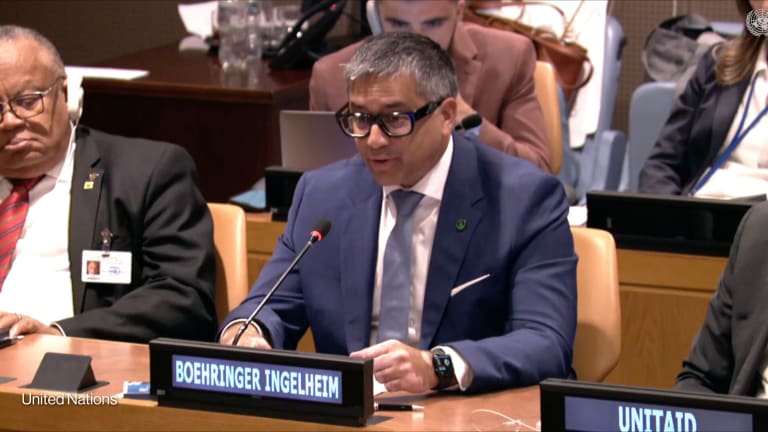
Over 2,300 years ago, Greek philosopher Aristotle said that “if we believe that men have any personal rights at all as human beings, they have an absolute right to such measure of good health as society, and society alone, is able to give them.”
A recent series of three articles in The Journal of the Royal Society of Medicine examined just how short we have fallen in achieving that “absolute right,” and presents a challenging path toward doing so.
Eminent physician Sir Kenneth Stuart and distinguished veterinarian and microbiologist Lord (Lawson) Soulsby, trace the long history of man’s efforts to attain universal access to a minimum level of health, from Aristotle to the formation — in April 1948 — of the World Health Organization, an anniversary celebrated as World Health Day.
The goal of the WHO — amplified later that year in the Universal Declaration of Human Rights — is to ensure the attainment by the entire world’s people of the highest possible level of health.
One does not have to look very far to see that this longstanding ideal remains unattained, within individual countries and between them.
Here in Britain, four major reports over the past 30 years have found that, despite continuous improvement, the gap in health outcomes between those at the top and bottom of the social scale remains significant and, in some instances, continues to worsen.
Nevertheless, the eradication of smallpox in 1980 and rinderpest in 2012, the near-elimination of polio and guinea worm and the dramatic reductions in Chagas disease and Onchocerciasis (river blindness) proves that unified, global programs can bear fruit in the form of dramatic health interventions that can save and improve the lives of millions of people worldwide.
At the same time, international travel and population shifts have made it possible for infectious diseases which, until recently, were thought to be confined to the developing world – Ebola, West Nile Virus, African Swine Flu and others – to be spread within hours to people in London or New York.
The result is an increasing “globalization” in the framing of our public health strategies. To be effective, we must think in terms of a uniform approach to improving health outcomes everywhere.
Lack of access to health is a function of poverty. Internationally, the income gap between the one-fifth of the world’s population living in the world’s richest countries and their counterparts in the world’s poorest, has only widened with globalization, from 30:1 in 1960 to 60:1 in 1990. Worse, the actual number of people living in poverty increased by almost 100 million during the 1990s, even as total world income grew by 2.5 percent in each year of the decade.
Factors besides poverty are also at work, including infrastructure, social services, education, housing, population planning, fresh water and electrical delivery, agriculture and livestock management – factors that lie well beyond the portfolios of the world’s existing departments and ministries of health. These causes, insidious though they are, usually fall to the bottom of the priority list for individual nations and global organizations.
At the same time, non-communicable diseases such as hypertension, coronary heart disease, diabetes, obesity, stroke and the consequences of smoking are no longer restricted to the developed world. Today, they kill more people worldwide than malaria, AIDS, tuberculosis and several other infectious diseases combined. These are diseases of lifestyle and education: Far from being inevitable, their elimination will require a transformation in our thinking about the role of public health, one that is geared toward prevention strategies rather than curative ones.
Recent years have seen an upsurge in funding for scientific initiatives to improve public health from governmental, intergovernmental, charitable and private sources alike. But that support has been uncoordinated, with donor priorities often taking precedence over national and international ones.
To meet these complex challenges, Stuart and Soulsby recommend that each country establish a “National Council for the Reduction of Health Inequalities,” empowered to coordinate the efforts of governmental agencies as well as professional groups and civil society.
Internationally, the array of issues and stakeholders is such that the coordination of the World Health Organization and its Global Commission on the Social Determinants of Health will be critical.
So, too, will be the Commonwealth, whose 54 countries, with a combined population of 2 billion – roughly 30 percent of the world’s population – have a long history of international collaboration.
Academic, nongovernmental and philanthropic organizations will also need to be enlisted, not to mention the pharmaceutical industry, which the authors credit with already having contributed mightily to the fight against health inequalities through research activities and by making low-cost drugs and biologics available to those who could otherwise not afford them.
What is at stake is much more than the achievement of improved global wellbeing. Underlying all the statistics cited by Stuart and Soulsby and at the core of the challenges they have identified are countless lives that can be improved, suffering that can be alleviated, and sheer human potential that can be realized.
Join the Devex community and access more in-depth analysis, breaking news and business advice – and a host of other services – on international development, humanitarian aid and global health.








